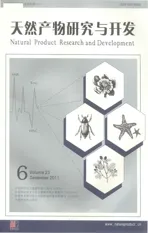华钩藤化学成分研究
2011-09-11刘明川胡德禹宋宝安杨松金林红
刘明川,胡德禹,宋宝安,杨松,金林红
贵州大学精细化工研究开发中心,教育部绿色农药与农业生物工程重点实验室,贵阳550025
华钩藤化学成分研究
刘明川,胡德禹,宋宝安,杨松*,金林红
贵州大学精细化工研究开发中心,教育部绿色农药与农业生物工程重点实验室,贵阳550025
从华钩藤(Uncaria sinensis(Oliv.)Havil)的乙醇溶液中分离得到8个化合物,经波谱学方法并与已知样
品对照段鉴定为:β-谷甾醇(1)、胡萝卜苷(2)、翅果定碱(3)、乌苏酸(4)、丁香色原酮甙I(5)、美商陆甙A(6)、
东莨菪素(7)和乌苏醛(8)。其中化合物5和6为首次从该植物中分离得到。
华钩藤;化学成分
Introduction
Uncaria sinensis(Oliv.)Havil(Gouteng in Chinese) is widely distributed in southwestern of China,mainly in Guizhou,Guangxi,and there are 14 species in China[1-2],among which 11 species are listed in Table 1.

Table 1 The distribution of the Uncaria Schreb.in China

U.scandens(Smith)HutchYunnan,Guangxi.U.yunnanensis K.C.HsiaYunnan U.laevigata Wal.ex G.DonYunnan U.homomalla MiqGuangxi
The whole plant of U.sinensis has been used for protecting liver,activating blood and antihypertensive for a long time[3,4].Nowadays,more and more researchers have found that this plant's non-alkaloid parts also could be used as anticancer agents.Yang et al.[5]reported the triterpene compounds isolated from U.macrophylla Wall show anticancer bioactivity.Ursolic acid,3β-6β-23-trihydroxyurs-12-en-28-oic acid,showed proliferation inhibitory activity against U2OS with the inhibition rate 43.8%at the dosage of 25 mg/kg.d,while that of compound 3β-6β-23-trihydroxyurs-12-en-28-oic acid was 30.07%at 25 mg/kg.d.Mitsuo et al.[6]reported that the methanol extract from U.sinensis showed a suppressive effect on umu gene expression of the SOS response in Salmonella typhimurium TA1535/pSK1002 against the mutagen 3-amino-1,4-dimethyl-5H-pyrido[4,3b]indole(Trp-P-1).Ursolic acid that was isolated from U.sinensis showed strong inhibiting effect and its ID50was 0.17 μmol/mL.
As far as we know,the chemical ingredients of U.sinensis were not reported yet.In this paper,the chemical constituents,especially the triterpene natural products from U.sinensis grown in Guizhou,were investigated.
Experimental
General
Melting point was determined on X4 melting point apparatus and the thermometer was uncorrected.1H and13C NMR spectra were recorded on a JOEL-ECX500 NMR instrument.LC-MS spectra were taken on an Agilent 1100/MSD.IR spectra were obtained on a SHIMADZU-IR Prestige-21,(KBr disks).Silica gel(200-300 mesh,Qingdao Ocean Chemical Co.,Ltd,China) were used for column chromatographic separations.
Plant material
The plant of U.sinensis was purchased from Guizhou Province in August 2007,and identified by Professor Long Qingde(Guiyang Medical College).The voucher specimens were deposited at Guiyang Medical College,Guiyang,China.
Extraction and isolation
The powdered U.sinensis(15 kg)was extracted with 85%EtOH(3×50 L)under reflux,6 h for the fist time,3h for the second time and 1h for the last time.After removal of the solvents by evaporation in vacco,the extract was suspended in water and then extracted with petroleum ether(10 L×3 times),ethyl acetate (10 L×3times)and n-butanol(10 L×3 times)respectively.The petroleum ether(127 g)was subjected to silica gel column chromatography with petroleum ether:EtOAc(100∶1-1∶1)to give 14 fractions,then we use the silica gel column chromatography to separate those fractions.Finally we obtained 3 compounds 1(64 mg),2(14 mg),3(60 mg).The ethyl acetate extract (346 g)was subjected to silica gel column chromatography with petroleum ether:CH3COCH3(100∶1-1∶1) to give 16 fractions.We used the silica gel column chromatography to separate those fractions again,and got five compounds from those fractions:4(120 mg),5 (9 mg),6(53 mg),7(30 mg)and 8(4 mg).
Structure Identification:
Compound 1White needles,mp.132-134℃,IR (KBr)cm-1:3429,2958,1462,1377,1053.The TLC of compound 1 was the same as β-sitosterol,so it was identified as β-sitosterol[4].
Compound 2White powder,mp.298-301℃,IR (KBr)cm-1:3398,2958,1462,1374,1024.The TLC of compound 2 was the same as daucosterol,so it was identified as daucosterol[7].
Compound 3White powder,mp.212-214℃,EI-MS m/z:368[M]+,337,353,223,180,130,69.IR (KBr)cm-1:3203,2945,1740,1676,1360.1H NMR (CDCl3,500 MHz)δ:0.88,1.42(3H,d,J=10 Hz,H-22),1.60,1.71,2.00,2.17,2.47,3.21,3.29,3.60(3H,s,H-24),4.34(1H,m,H-18),7.6.87-7.26(4H,m,H-9,10,11,12),7.41(1H,s),8.18 (1H,s).13C NMR(CDCl3,125 MHz)δ:18.6(C-22),30.1(C-14),30.4(C-15),34.8(C-20),37.8 (C-6),51.0(C-21),53.5(C-24),54.1(C-5),56.9(C-7),71.2(C-3),72.1(C-19),109.5(C-9),109.8(C-16),122.5(C-12),124.5(C-11),127.5(C-10),133.7(C-8),140.1(C-13),154.9 (C-17),167.63(C-23),181.1(C-2).The IR,1H NMR,13C NMR and EI-MS data are in agreement with those of reported data of pteropodine,so we identify it as pteropodine[8].
Compound 4White powder,mp.257-260℃.IR (KBr)cm-1:3450,2926,1695(C=O),1456,1028,997.1H NMR:(500 MHz,CD3OH)δ:0.78(s,CH3),0.82(s,CH3),0.89(d,J=5 Hz,CH3),1.16 (s,CH3),3.2(1H,q,J=5.3 Hz,H-3),5.2(1H,t,J=1.5 Hz,H-12).13C NMR(CDCl3,125 MHz)δ: 14.6(C-29),14.7(C-30),16.2(C-23),16.5(C-24),18.1(C-26),20.1(C-25),22.7(C-11),23.0 (C-3),24.0(C-21),26.6(C-15),27.4(C-7),27.9(C-16),30.4(C-6),33.0(C-22),36.7(C-12),36.8(C-5),38.5(C-13),38.7(C-20),39.0 (C-9),39.1(C-19),39.5(C-14),41.9(C-10),53.1(C-18),55.4(C-9),78.4(C-8),125.6(C-2),138.3(C-1),180.1(C-28).The TLC of compound 4 was the same as ursolic acid,and IR,1HNMR,13C NMR data are in agreement with those of reported data of ursolic acid[9].
Compound 5White powder,mp.245-248℃,EI-MS m/z:354[M]+,192,164,69,IR(KBr)cm-1:3429(-OH),2926,1669(C=O),1442,1091,677.1H NMR (CD3OD,500 MHz)δ:3.39~3.41(3H,m,H-2',6'),3.49~3.52(1H,m,H-5'),3.8~3.9(2H,m,H-3',4'),4.6~5.01(4H,m,glc-OH),5.05(1H,d,J=10 Hz,H-1'),2.3(3H,s,H-9),6.1(2H,s,H-5,6),6.4(1H,s,H-7),6.6(1H,s,H-2).13C NMR (CD3OD,125 MHz)δ:19.0(C-9),61.0(C-6'),69.8(C-4'),73.3(C-2'),76.4(C-3'),77.0(C-5'),94.5(C-1'),107.9(C-7),100.2(C-8a),105.4(C-2),99.6(C-5),158.0(C-4a),161.6(C-6),163.4(C-8),168.6(C-3),182.8(C-1).The IR,1H NMR,13C NMR and EI-MS data are in agreement with those of reported data of eugenoside I[10,11].
Compound 6White flake,mp.230-234℃,IR (KBr)cm-1:3400(-OH),2972,1683(C=O),1047.1H NMR(CD3OD,500 MHz)δ:3.80(2H,d,J =10 Hz,H-2'),3.26~3.35(2H,m,H-3',4'),3.61 (1H,q,J=5 Hz,H-5'),4.32(1H,d,J=5 Hz,H-6'),5.57(1H,t,J=5 Hz,H-2),4.1(3H,s,H-31),4.3(2H,d,J=5 Hz,H-24),2.27~0.72 is the hydrogen on the six-member rings.13C NMR(CD3OD,125 MHz)δ:177.8(C-28),175.8(C-29),132.7 (C-1),128.9(C-2),105.6(C-1'),88.4(C-8),77.3(C-3'),76.4(C-2'),74.6(C-4'),71.0(C-5'),62.3(C-24),55.6(C-31),55.8(C-17),55.6 (C-10),54.2(C-4),47.8(C-9),46.7(C-14),39.5(C-18),39.0(C-19),38.7(C-20),38.5(C-5),37.0(C-13),36.7(C-12),36.5(C-6),36.2 (C-21),30.0(C-15),29.7(C-22),27.5(C-16),26.0(C-3),24.5(C-7),22.6(C-30),20.63(C-27),18.1(C-25),17.1(C-11),16.1(C-26),15.9 (C-23).The IR,1H NMR,13C NMR data are in agreement with those of reported data of phytolaccoside A[12].
Compound 7Yellow needles,mp.202-204℃,1H NMR(CD3COCD3,500 MHz)δ:8.75(1H,s,OH),7.82(1H,d,J=10 Hz,H-4),7.16(1H,s,H-5),6.76(1H,s,H-8),6.15(1H,d,J=10 Hz,H-3),3.87(3H,s,OCH3).13C NMR(CD3COCD3,125 MHz)δ:160.4(C-2),150.9(C-9),150.3(C-7), 145.1(C-4),143.8(C-6),112.5(C-10),111.2 (C-3),109.1(C-5),102.8(C-8),55.8(OCH3) .The IR,1H NMR,13C NMR data are in agreement with those of reported data of scopoletin[13].
Compound 8White powder,mp.236-238℃,IR (KBr)cm-1:2926,1730.1H NMR(CDCl3,500 MHz) δ:0.77(s,CH3),0.85(s,CH3),0.87(d,J=6.5 Hz,CH3),1.08(s.CH3),3.2(s,br.3-H),5.2 (1H,t,J=1.6 Hz,12-H).13C NMR(CDCl3,125 MHz)δ:15.5(C-29),15.6(C-30),17.0(C-23),17.1(C-24),18.3(C-26),21.2(C-25),23.3(C-11),23.6(C-3),24.2(C-21),27.3(C-15),28.0 (C-7),28.2(C-16),29.7(C-6),31.0(C-22),36.7(C-12),37.0(C-5),38.6(C-13),38.8(C-20),38.9(C-9),39.1(C-19),39.5(C-14),41.9(C-10),47.9(C-17),47.6(C-4),52.7(C-18),〗55.3(C-9),79.1(C-8),125.9(C-2),138.0(C-1),207.1(C-28).The IR,1H and13C NMR data are in agreement with those of reported data of ursolic aldehyde[14].
Acknowledgment This work is financially supported by Program for Excellent Scientist of Guizhou Province ([2005]0515),Key Science and Technology Project of Guizhou Province(No.20076004),and the National Key Technology R&D Program(2006BAD07A12).
1Liu J,Fu ZJ.General Situation of the Study on the U.Rhynchophylla.Strait Pharm,2006,18:90-94.
2He Y,Hong XK,Wang ZH.Pharmacological Development of Ramulus uncaraecum Uncis and Its Active Ingredients.Shanghai J Tradit Chin Med,2003,37:57-61.
3Liu G,Feng XZ.The General Research of Uncara rhymchopylla.Chin Pharm J,1991,26:583-591.
4Yang J,Song CQ,Hu ZB.Studies on Constituents in U.macrophylla Wall.J Chin Mat Med,2000,25:484-485.
5Yang J,Zhang YW,Song CQ,et al.Effect of Non-alkaloid Components in U.macrophylla Wall.J Plant Resour Environ,2001,10:55-56.
6Mitsuo M,Yoshiharu O,Koji I.Suppression of the SOS-inducing activity of mutagenic heterocyclic amine,Trp-P-1,by triterpenoid from U.sinensis in the Salmonella typhimurium TA1535/pSK 1002 Umu Test.J Agric Food Chem,2005,53: 2312-2315.
7Su ZH,Liu MS,Li ZL,et al.Chemical Constituents of Ancistrocladus tectorius.Chin J Med Chem,2007,17:383-386.
8Liu HM,Yang JZ,Liu G,et al.Chemical Constituents of U.sinensis(Oliv.)Havil.Chin Tradit Herb Drug,1993,24:61-63.
9Zhang YH,Chen DL,Wang FP.Studies on chemical constituents of Periploca omeiensis.Nat Prod Res Dev(天然产物研究与开发),2006,18:772-774.
10 Rao GX,Dai YH,Wang LX(王立新),et al.Chemical constituents from Ligustium pteridophyllum.Acta Bot Yunnan,1991,13:233-236.
11 Zhang YW,Chen Y.Isobiflorin,a chromone C-glucoside from cloves(Eugenia caryophyllata).Phytochem,1997,45:401-403.
12 Strauss A,Spengel SM,Schaffner W.Saponins from root cultures of Phytolacca acinosa.Phytochem,1995,38:861-865.
13 Luo JG,Kong LY.Lipophilic constituents from the leaves of Ipomoea batatas(CV.Simon).Nat Prod Res Dev(天然产物研究与开发),2005,17:166-168.
14 Zhao LX,Pei XJ,Liu NN,et al.Sythesis and characterization of ursolic aldehyde and oleanolic aldehyde.Chin Mater Sci Tech Equip,2008,3:71-73.
Chemical Constituents from Uncaria sinensis(Oliv.)Havil
LIU Ming-chuan,HU De-yu,SONG Bao-an,YANG Song*,JIN Lin-hong
National-Guizhou Joint Laboratory of Biomass Comprehensive Utilization,Key Laboratory of Green Pesticide and Agricultural Bioengineering,Ministry of Education,Center for R&D of Fine Chemicals,Guizhou University,Guiyang 550025,China
Eight compounds were isolated from Uncaria sinensis(Oliv.)Havil and their structures were identified by means of spectroscopic analysis as β-sitosterol(1),daucosterol(2),pteropodine(3),ursolic acid(4),eugenoside I (5),phytolaccoside A(6),scopoletin(7),and ursolic aldehyde(8).Compounds 5 and 6 were isolated from the U.sinensis for the first time.
Uncaria sinensis;chemical constituents
February 22,2010;Accepted May 11,2010
This work is financially supported by Program for Excellent Scientist of Guizhou Province([2005]0515),Key Science and Technology Project of Guizhou Province(No.20076004),and the National Key Technology R&D Program(2006BAD07A12).
book=2011,ebook=23
R284.1;Q946.91
A
1001-6880(2011)06-1058-04
*Correspondence authorTel:86-851-8292171;E-mail:jhzx.msm@
gmail.com
